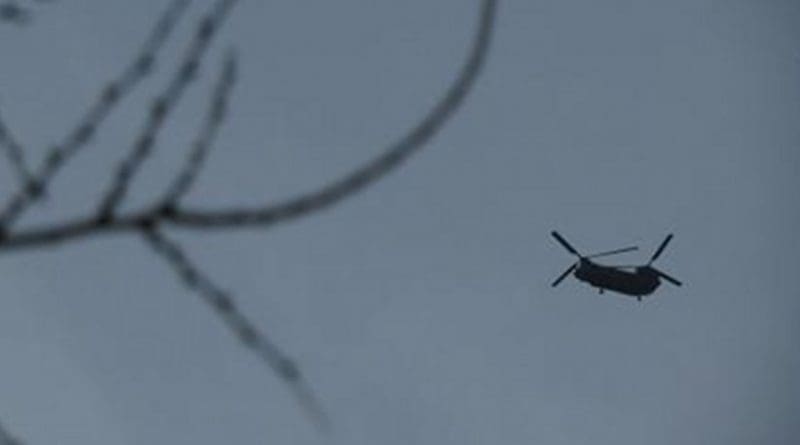Giving Iran And Afghanistan On A Platter To China – Analysis
By Lt Gen Prakash Katoch (retd)*
The US has shut down five military bases in Afghanistan located in Helmand, Uruzgan, Paktika and Laghman provinces in accordance with the US-Taliban agreement signed on February 29. Zalmay Khalilzad, US Special Representative for Afghan Reconciliation, has said, “The US has worked hard to carry out the 1st phase of its commitments under the Agreement, including to reduce forces and depart five bases. NATO troops have come down in proportional numbers.”
Under the deal, the US had 135 days to fulfill its pledge to reduce troops to 8,600 from nearly 14,000 in Afghanistan, which it has done. The deal aimed at reducing violence in Afghanistan and initiating intra-Afghan talks leading to peace. However, violence in Afghanistan has increased exponentially, though the Taliban refrained from targeting US-NATO troops. Also, Taliban had agreed not to allow al-Qaeda, Daesh, and other militant groups to operate in areas they control as part of the pact, but evidence indicates these groups continue operating in Afghanistan, including Pakistan-based terror groups like Haqqani network, Lashkar-e-Taiba and Jaish-i-Mohammad. Intra-Afghan talks are yet to begin.
US President Donald Trump’s compulsion was his pre-election promise to “bring the boys home”. Trump has now tweeted, “We are acting as a police force, not the fighting force that we are, in Afghanistan. After 19 years, it is time for them to police their own country. Bring our soldiers back home but closely watch what is going on and strike with a thunder-like never before, if necessary.”
China gains
What shape the “strike with a thunder-like never before” can take other than bombings and with what effect only time will tell but the power vacuum in Afghanistan is sure to be filled by China who at some stage may consider an attack on Afghanistan like an attack on itself, given that China will capitalize on the US$1-3 trillion mineral reserves of Afghanistan. Recall in 2011, Iran-based ‘Green Experts’ had quoted PLA’s Major General Zhang Zhaozhong stating, “China will not hesitate to protect Iran even with a third World War.”
Iran and China signed a deal in 2011 that gave Beijing exclusive rights to several Iranian oil and natural gas fields till 2024. Chinese oil companies were granted exclusive rights to three Iranian regions atop oil reserves and the right to build the necessary infrastructure for these regions. China promised to treat any foreign attack against these regions as attacks against its own sovereign territory. Additionally, China was given the right to “maintain and increase its military presence” in Iran plus control movement of Iranians in and out of these territories without any permission from the Iranian government. In 2019, Iran formally joined China’s ‘One Belt One Road’ initiative.
In June 2020, the Iranian cabinet approved the Iran-China partnership proposed by President Xi Jinping when he visited Iran in 2016. Under this partnership, China will invest $400 billion in Iran over 25 years, which will expand Chinese presence in Iran’s banking, telecommunications, ports, railways and dozens of other projects. The partnership includes Chinese involvement in Chabahar’s duty-free zone, an oil refinery nearby, and possibly a larger role in Chabahar Port as well.
In exchange, China will receive a regular supply of Iranian oil at discounted rates for the next 25 years. Iran recently announced it will establish a base in the Indian Ocean, though the location has not been revealed. It is logical that this port will be developed by China and will have access to Chinese warships and submarines.
Notably, the US took the decision by design or default to give Iran and Afghanistan to China on a plate even before China’s biological attack. US media says Iran’s desperation has pushed it into the arms of China but it is the US sanctions including the threat to cut off access to the international banking system for any company that does business in Iran which is the reason – the same way as the US pushed Russia closer to China. China naturally pounced on the opportunity for enhancing its geostrategic influence in Iran together with economic gains.
Not in Indian interests
The US actions have not been in India’s strategic interests, especially after India stopped total oil imports from Iran under US pressure. China has dropped all pretenses of friendship against India with its recent aggression against India in Ladakh. China will use its increased presence and influence in Iran and Afghanistan to target Indian interests. Iran and Afghanistan will be optimized by China as strategic gateways to Central Asia, the Middle East, and to the Indian Ocean, as well as hemming in India which it views as an Asian rival and an ally of the US.
The US author, Robert D Kaplan wrote in his book ‘The Revenge of Geography’: “Pressure on land can help the United States thwart China at Sea.” But post exit from Afghanistan America will lose that advantage since its ‘Pivot Asia’ will be largely reduced to the high seas.
Despite some ongoing India-China disengagement in Ladakh, the proximity of large PLA mechanized formations close to the Line of Actual Control indicates China may still force conflict on India, which can even be in conjunction with protégé Pakistan. This would be good for weapon-exporting countries, including the US, which may even speculate putting boots on the ground in India though this will unlikely be accepted.
*About the author: The author is an Indian Army veteran. The views expressed are personal
Source: This article was published by South Asia Monitor

